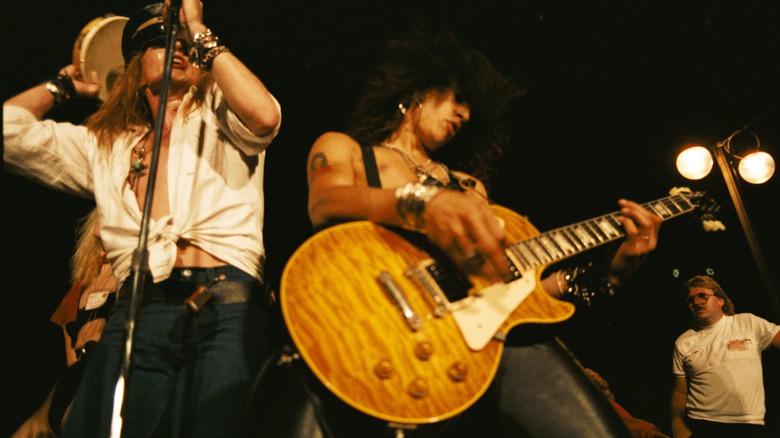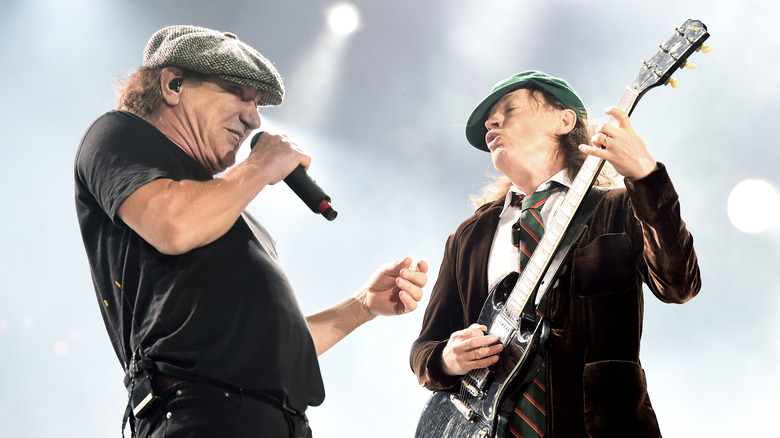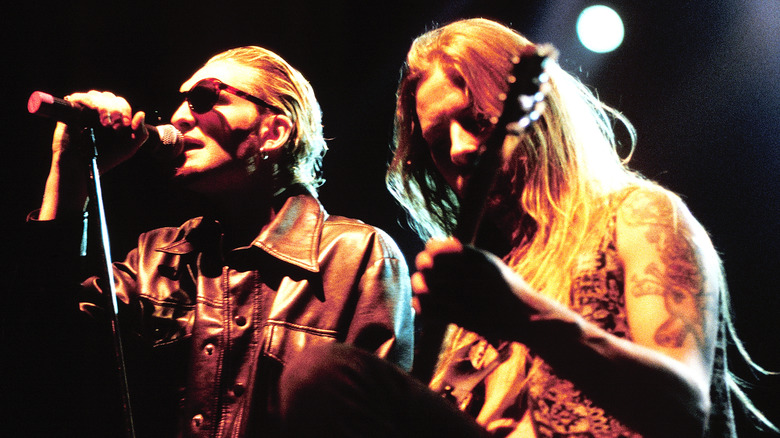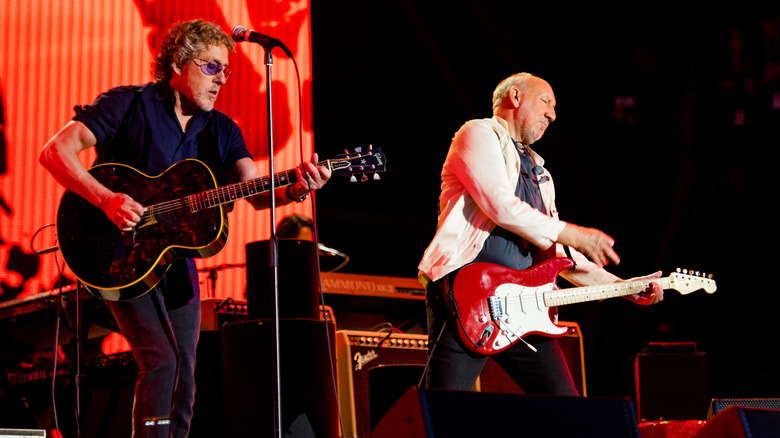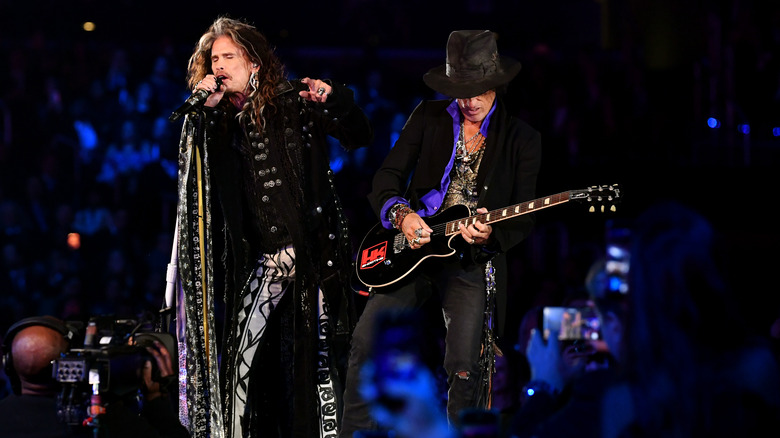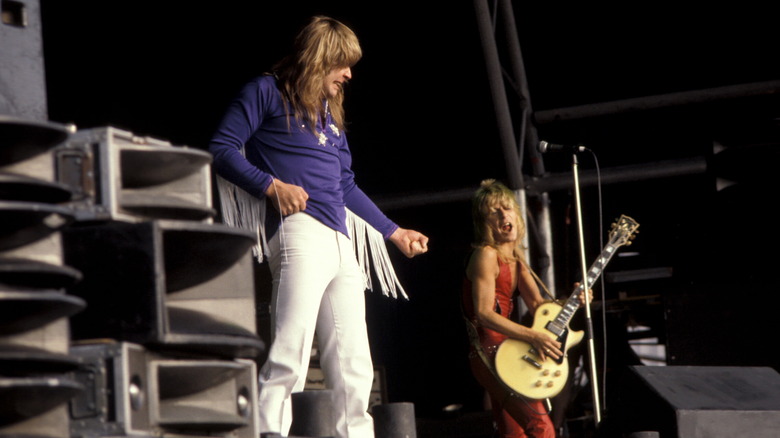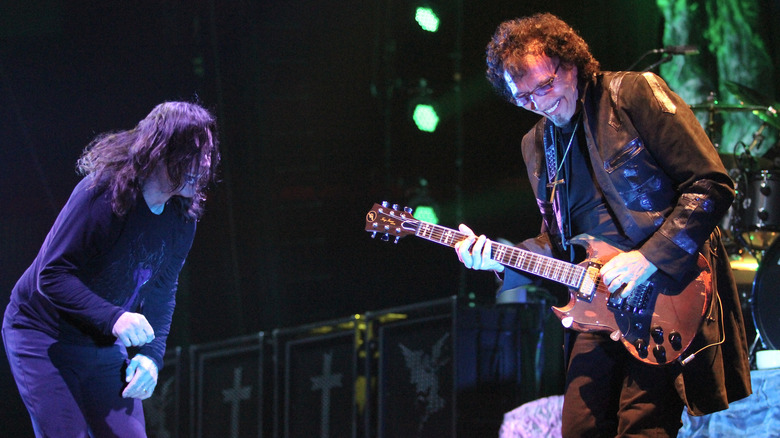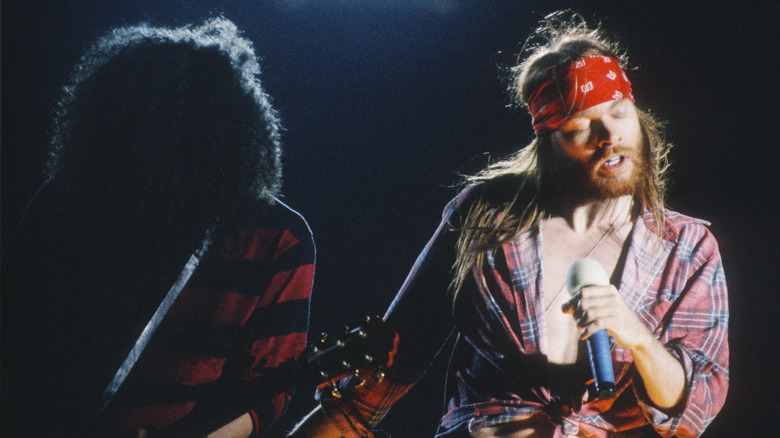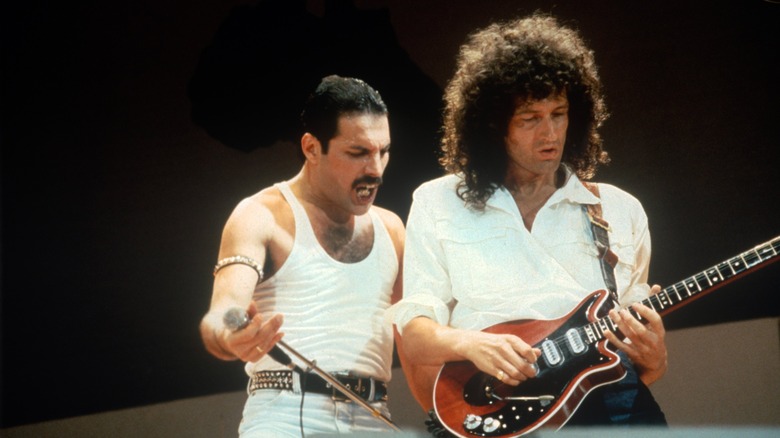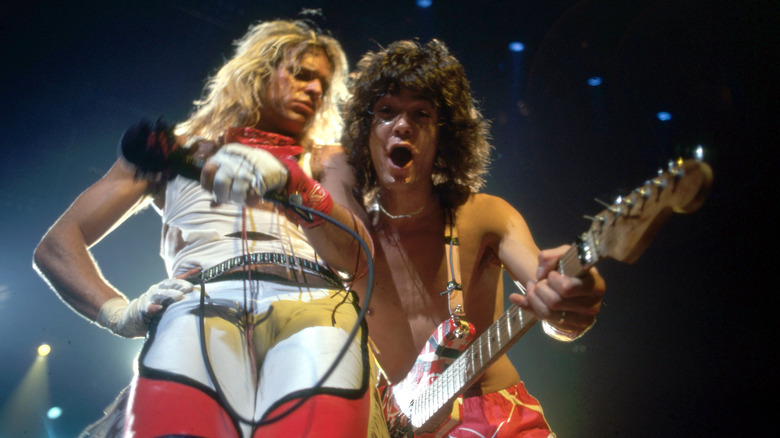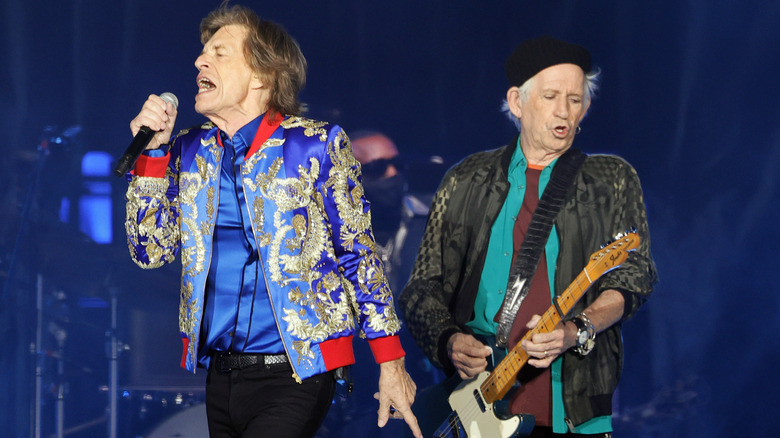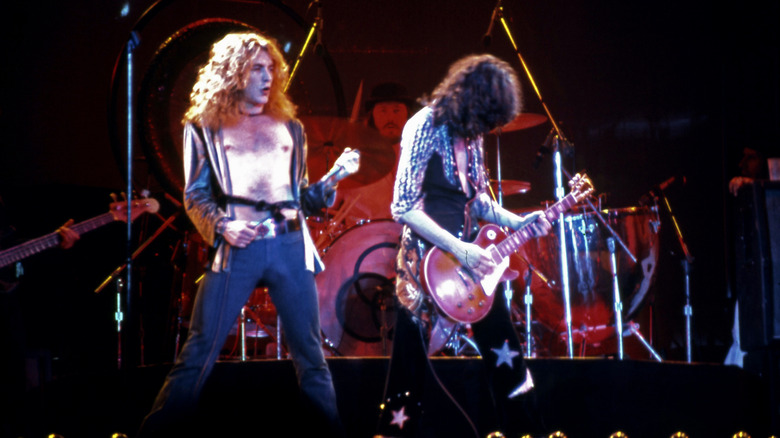Greatest Singer-Guitarist Duos In Rock History
Their relationships are almost always strained to the breaking point, but these rock 'n' roll superstars have got giant, clashing egos for a reason. In the best bands, the songwriting skills and onstage chemistry of the lead singer and the lead guitarist speaks for itself.
The history of rock is filled with these mighty one-two punches. So many, in fact, that many worthy duos — the Gallagher brothers from Oasis, Zach de la Rocha and Tom Morello from Rage Against The Machine, Phil Anselmo and Dimebag Darrell from Pantera, Bono and the Edge from U2, Corey Glover and Vernon Reid from Loving Colour, and Gerard Way and Ray Toro from My Chemical Romance along them — simply couldn't fit on this list. Believe us, we tried.
So who's in the running for best one-two punch in rock history? From AC/DC to Alice In Chains to Aerosmith to Guns N' Roses, Van Halen and The Who, here are some of the best of the best right here. These are the greatest singer guitarist duos in the history of rock 'n' roll.
Brian Johnson and Angus Young -- AC/DC
AC/DC lost its former singer, Bon Scott, after a night of binge drinking in 1980. "For us, it was like losing a member of your family," lead guitarist Angus Young said in an interview after the tragedy, according to Ultimate Classic Rock. "It's very, very difficult to go through something like that. Not only is it your friend, it's also somebody you've been working with all that time."
Of course, the loss of a lead singer should be the end of just about any band. But AC/DC isn't just any band. Although they mourned, the group didn't hang up the guitars and drums. Singer Brian Johnson was hired months later. Their first album with him, "Back in Black," released later that same year and made famous by the title track — as well as "Hell's Bells," "Rock and Roll Ain't Noise Pollution," and "You Shook Me All Night Long" — isn't just the band's most successful record, but the single biggest rock record of all time, as noted by Guitar World.
Johnson was exactly what the group needed: a powerhouse vocalist with an inimitable voice, who could command a stage and massive stadium crowds. And yet, he's always been perfectly happy to defer to the band's true frontman, school boy uniform-wearing, duck-walking, Gibson SG wielding Young. Together they make up one of the finest, fiercest tag teams in rock 'n' roll history.
Layne Staley and Jerry Cantrell -- Alice In Chains
Nobody knew they were witnessing history when Alice In Chains took the stage on July 3, 1996. But Kerrang says it was the last show the tortured, metal-grunge group would ever play with original frontman Layne Staley. He became a recluse shortly after and died of a drug overdose in 2002, as per Billboard. It was a tremendous loss to the rock community. Staley's voice was without equal throughout the '90s, even among his grunge rock peers. He took all his pain and fear and used it to create something achingly beautiful and timeless.
But the fact that the band survived the loss of its most recognizable member, and his iconic sound, is a testament to another member: guitarist and backing vocalist Jerry Cantrell, who now splits singing duties with William DuVall (via AllMusic). Cantrell's excellent voice, stellar musicianship, and beautiful songwriting was and always has been the heart of Alice In Chains' dark brilliance. Together, he and Staley were a powerhouse duo. It was an era of musical revolution: Nirvana ended the era of what most would refer to as "classic" rock, according to FiveThirtyEight, paving the way to the genre's modern era. Other grunge bands like Alice In Chains were part of this movement, defined by a rejection of everything that came before. But Staley and Cantrell took their singer-guitarist dynamic straight from the greatest classic bands and did it as well as any of them.
Roger Daltrey and Pete Townshend -- The Who
As is the case with many creative partnerships, Roger Daltry and Pete Townshend — the lead singer and guitar player of The Who, respectively — have not always gotten along. Far Out Magazine says that at the heart of their conflict was lack of communication and dialogue.
But their decades of tension didn't stop their rapid ascent to rock 'n' roll godhood in the 1960's. Wrote Pearl Jam's Eddie Vedder for Rolling Stone: "The Who began as spectacle. They became spectacular. ... Pete [could] wring notes out of his guitar like a mechanic squeezing oil from a rag. ... Roger Daltry's delivery allowed vulnerability without weakness; doubt and confusion, but no plea for sympathy."
It's true. Daltry was a mere mortal, but that voice of his was — and is — something else. Few other singers in any genre have as much raw power, and age hasn't softened his edge. Townshend is a perfect match because he has just as much power, channeled into huge power cords only playable by sweeping windmill strokes.
Together, supported by bassist John Entwhistle and drummer Keith Moon in the rhythm section, these two were the embodiment of rock's youthful, rebellious spirit.
Steven Tyler and Joe Perry -- Aerosmith
The Toxic Twins (named after their legendary drug abuse during their heyday, per NME) are one of those creative teams that work because they're opposites. It's hard to find a more eccentric personality in rock than Steven Tyler. You can see and hear him from miles away. He howls and screams and still somehow hits the right notes. And Joe Perry was the roll to Steven's rock: He just takes it easy beside him, wailing on the axe without breaking a sweat. Has anyone ever looked so cool on stage?
What makes Aerosmith so unique, other than how they helped pioneer a style of rock that would dominate the '70s and '80s, as per their Hall of Fame profile, is how they made what just might be the greatest comeback in rock history.
In 1979, giant egos, substance abuse, and infighting led to Perry leaving the band (via Ultimate Classic Rock). Neither his Joe Perry Project nor Aerosmith itself came close to the heights they enjoyed in the '70s, until Perry returned in 1984. According to Ultimate Classic Rock, "Pump," "Permanent Vacation," and a remix of their hit "Walk this Way" with hip hop superstars Run DMC helped them enter the '90s as one of the hottest, most forward thinking bands in rock.
It's hard, and a little depressing, to imagine where pop music would be without the bad boys from Boston — especially Tyler and Perry: one of rock n' roll's greatest ever one-two punches.
Ozzy Osbourne and Randy Rhoads
Ozzy Osbourne's groundbreaking career with Black Sabbath ended unceremoniously at the end of the '70s, according to Ultimate Classic Rock. But the Prince of Darkness was far from down and out of the fight. He launched a solo career that helped define '80s hard rock and heavy metal, always flanked by some of the decade's most accomplished shredders. Jake E. Lee and Zakk Wylde are legends in and of themselves, as per AllMusic.
But any true fan knows Osbourne's first guitarist was his greatest. Enter young Randy Rhoads. His profile from the Rock & Roll Hall of Fame acknowledges the indelible mark he made in music, calling him "one of the most important and influential guitarists of all time." His profile also notes that the blond-headed rocker's training in classic music played a huge role in his style, marked by "a high-speed, technical style of guitar soloing ... that came to define metal in the 1980s and beyond."
Together, the heavy metal, bat-eating madman and the hotshot kid with the Les Paul guitar produced some of rock history's most head-bangable anthems, from "Crazy Train" and "Mr. Crowley" off 1980's "Blizzard of Ozz," and "Flying High Again" from the following year's "Diary of a Madman." Rhoads tragically died in a 1982 plane crash, according to Ultimate Classic Rock, but his mighty influence lives on.
Ozzy Osbourne and Tony Iommi -- Black Sabbath
By the early '70s, a whole new genre of rock was beginning to take shape: heavy metal. And there's Black Sabbath to thank for that, says Louder.
Sabbath was already playing a heavier form of rock 'n' roll. But three things set it apart, on a path to darker (and more influential) territory. First: the twisted lyrics and imagery, inspired by a nightmare bassist Geezer Butler had, of a black figure watching him at the end of his bed at night, as per Louder. Second: there were the haunted, maniacal wails of Ozzy Osbourne. The way he screams "What is this thing that stands before me?" on the band's eponymous single (from their self-titled album) — a reference to Butler's aforementioned nightmare — is enough to give you your own evil, chilling dreams.
Third: There's Tony Iommi. As he details in an interview, an industrial accident severed his fingertips, but not his will to play guitar. He made himself some tips for his fingers and, as Louder notes, also loosened the strings of his guitar to make it easier to play. That last part is important: looser strings means a heavier, darker sound.
Iommi's wicked riffs produced the sound of evil; Osbourne channeled its spirit. Heavy metal never looked back.
Axl Rose and Slash -- Guns N' Roses
"It was probably way overdue," Slash said of his 2015 reunion with Axl Rose (via NME). Fans had been waiting for this day for decades. But it's hard to imagine it coming earlier than it did. As the article notes, the bad blood shared between Axl and Slash went deep. Axl once said, "Not in this lifetime ..." in response to whether or not he'd ever work with Slash again, reports Ultimate Classic Rock. In 2016, they picked that quote as the name of a stadium-packing reunion tour.
The same dangerous, unpredictable energy that made them superstars was their undoing. It's a tale as old as time. But when they were making it work, not even their antics — Slash's hard partying, Axl storming off the stage or getting to it hours late, sometimes starting riots — overshadowed their music or performances.
The songs on "Appetite for Destruction," their 1987 debut, are about drug addiction, the dark side of hedonism, and anger at having to scratch out a living on the seedy streets of Los Angeles. It's a perfect rock 'n' roll record that wouldn't have been possible if its two leading men were in good shape. Rolling Stone listed it as one of the greatest albums of all time.
Freddie Mercury and Brian May -- Queen
On July 13, 1985, Queen joined other '80s superstars at the Live Aid charity show in the United Kingdom. As Holly Thomas notes for CNN, "Past their peak and reeling from the catastrophe of a misadvised run of shows in apartheid South Africa the previous year, Queen was not expected to shine." They didn't open or close the show. They didn't even have time for a full set. They had to break their hits, like "Bohemian Rhapsody" and "Radio Gaga," into little snippets and figure out how to string them together.
It might just be the greatest performance of all time. Everyone was in top form here, but the real star, of course, was Freddie Mercury. You've probably seen at least a few snippets of the show.
The thing is, the performance wasn't atypical for Queen. It's their most famous show, and maybe the most famous concert in history other than Woodstock. But bringing down the house in the world's biggest venues was just what they did.
Mercury is the greatest frontman of all time. Don't take our word for it — there's a research paper proving it. But there was also Brian May, Queen's frizzy-haired guitar hero. His licks and solos are never too restrained, and he never showboated. His work was simply tasteful. Together they produced some of the best music and greatest performances ever.
David Lee Roth and Eddie Van Halen -- Van Halen
Eddie Van Halen always let the music talk for him. Why wouldn't he? He could shred the six string better than almost any guitar player who ever lived. In fact, he revolutionized how the instrument was played. But unlike his countless imitators, notes Rolling Stone, his shredding was an art form, not showboating. He was impossible not to listen to.
David Lee Roth — flamboyant, loud, funny, an acrobat as much as a singer – was impossible to look away from. He believed this was the entertainment business, and that people weren't paying to see concerts where the musicians sat around and hammered out some tunes before going home. He had to make it a show because it was his job. As The Washington Post notes, Roth's personality and Van Halen's genius worked for a while. But, ultimately, the two were at odds over making music versus "being in a band." This led to a lot of tension and Roth's departure.
But it also produced a world-changing creative axis that set the stage for the '80s and beyond. It would be cheap to call what they had "magic." They worked hard for it. They were seasoned pros before they ever even hit the big stage. And when they did, nobody could do it like them.
Mick Jagger and Keith Richards -- The Rolling Stones
"Jagger had that conversational quality that came from R&B singers and bluesmen," writes Steven Van Zandt for Rolling Stone. "... The acceptance of Jagger's voice on pop radio was a turning point in rock & roll. He broke open the door for everyone else. Suddenly, Eric Burdon and Van Morrison weren't so weird — even Bob Dylan."
On the band's guitarist, he says, "Keith Richards has been taken for granted too, relegated historically to permanent rhythm guitar. But his solos were great."
With the Rolling Stones coming in at the height of the British Invasion of the mid to late '60s, Jagger and Richards were the original rock 'n' roll singer-guitarist duo. What's strange is that although that blueprint has been riffed on ad nauseum, it's never been improved upon. How could it be? They did everything right from the get go.
Jagger is a hip-swinging, gyrating musical force of nature. Richards is a rhythm guitarist who can make musical magic with the simplest licks and fills. He never needed to shred. He was above than that kind of showboating. Together, they're as unstoppable today as they were when they first terrified parents in the '60s. They have a timeless kind of chemistry. It was there when they were young and hungry. It's still there, now that they're respected elder statesmen of rock. And it'll still be there years after they're gone, when your grandkids hear classic Stones for the first time.
Robert Plant and Jimmy Page -- Led Zeppelin
"I consider Jimmy Page freakier than Jimi Hendrix," Dave Grohl wrote for Rolling Stone. "Hendrix was a genius on fire, whereas Page was a genius possessed."
As for lead singer Robert Plant, well, you don't get voted the greatest voice in rock, according to NME, by accident.
Led Zeppelin shows were almost a little strange. If you watch them, you don't see Plant or Page (or Brian Jones or John Bonham for that matter) interacting with the crowd that much. Plant isn't sticking his mic towards the audience for the chorus. Page isn't crowd surfing while he shreds. Maybe it's because they predated that kind of thing. But maybe it's because a Led Zeppelin show was a different kind of experience.
You weren't just going to see your favorite band play the hits. You were watching four guys channel music from the ether, like some form of dark magic, almost like they didn't know or care if the audience was watching them play at all. Plant would just stand there, often with his eyes closed, twirling his hand, lost in the music. But he brought the house down like nobody's business. And Page was too caught up in the instrument he'd mastered to waste time looking at you. But more mesmerizing musicians to watch or listen to never existed. Somehow, without all the showboating, they still brought enough wicked cool swagger and musical magic to become the quintessential singer-guitarist duo: endlessly imitated, never equaled.
